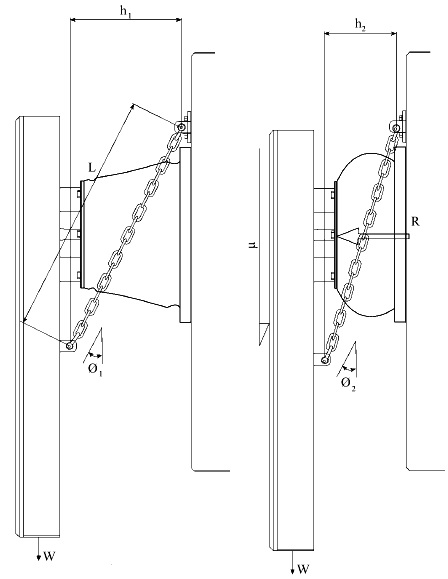Chain Design
Chain Design
There are three types of chains in marine fendering systems:
1. Tension Chain: The main function of the tension chain is to protect the fender from damage while it is under compression.
2. Weight Chain: The weight chained is used to support the weight of the frontal and face panel.
3. Shear Chain: This chain protects the fender from damage while in shear deflection.
The following should be noted in the chain design:
- Chain dimensions should be as exact as possible. Not too loose, not too tight.
- The chain can not be twisted as this reduces the load capacity.
- Open Link is preferred.
- The initial(static) angle of the chain is important. Normally weight chains are set at a static angle of 15 - 25° to the vertical and shear chains are set to 20 - 30° to the horizontal.
- All chains must be designed or selected with a safety factor of 2 to 3 times of the work load.
- The dimensions of the shackle is usually the same as the chain, but if the shackle is required to bear the same load with the chain, then a thicker shackle is preferred. 
h1=L●Sin (Ф1) h2=h1 - D
Ф2=arcsin [(h1-D)/L] FL=μ●ΣR + W / 9.81●n●CosФ2 FM=FS●FL
Where,
Ф1: Static Angle of Chain(°)
h1: Static offset between brackets(m, ft)
Ф2: Dynamic Angle of Chain(°)
h2: Dynamic offset between brackets at F(m, ft)
D: Fender compression(m, ft)
ΣR: Reaction Force of rubber units behind the frontal panel(N, Lbs)
W: Weight of the panel face(N, Lbs)
FL: Safe working Load of chain(N, Lbs)
L: Bearing length of chain(m, ft)
n: number of chains acting together
μ: Friction coefficient of face pad. Usually equals 0.15 for UHMW-PE facings.
FM: Minimum Breaking Load(N, Lbs)
FS: Safety Factor(2~3 times)